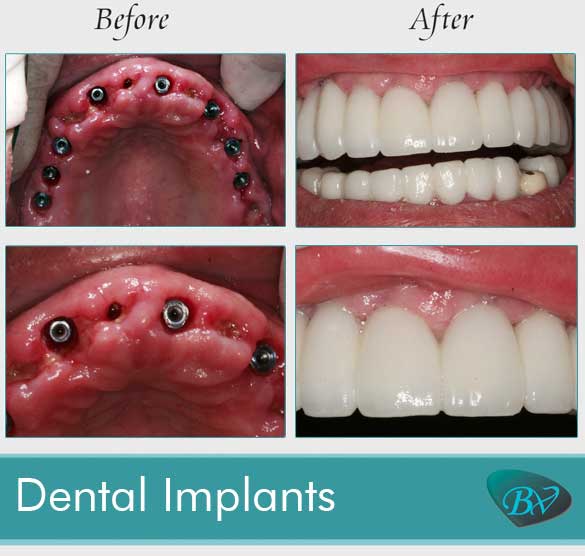See This Report on Dental Sense
See This Report on Dental Sense
Blog Article
Top Guidelines Of Dental Sense
Table of ContentsTop Guidelines Of Dental SenseThe Dental Sense StatementsSome Known Factual Statements About Dental Sense See This Report about Dental Sense
are medical gadgets surgically dental implanted right into the jaw to restore a person's ability to eat or their appearance. They provide assistance for fabricated (fake) teeth, such as crowns, bridges, or dentures. When a tooth is shed due to injury or illness, an individual can experience complications such as rapid bone loss, faulty speech, or changes to eating patterns that lead to pain.Oral implant systems contain a dental implant body and dental implant abutment and may also consist of an abutment addiction screw. Front tooth filling. The dental implant body is surgically placed in the jawbone in location of the tooth's origin. The dental implant abutment is generally connected to the dental implant body by the abutment fixation screw and extends through gums right into the mouth to sustain the connected artificial teeth
(https://justpaste.it/hj6ob)Structure of The Oral Implant System picking dental implants, talk with your dental provider regarding the potential advantages and dangers, and whether you are a candidate for the treatment. Things to take into consideration: Your overall health and wellness is an essential element in identifying whether you are a good prospect for oral implants, how much time it will certainly require to recover, and just how long the implant might stay in place.
Cigarette smoking might influence the recovery process and lower the lasting success of the dental implant. The healing process for the dental implant body might take numerous months or longer, throughout which time you typically have a short-term joint instead of the tooth. the oral implant procedure: Meticulously adhere to the dental health directions offered to you by your oral copyright.
What Does Dental Sense Do?
Implant failure can cause the demand for another surgery to take care of or replace the implant system. Recovers the ability to eat Recovers cosmetic appearance Helps maintain the jawbone from diminishing as a result of bone loss Preserves the wellness of the bordering bone and gum tissues Helps maintain nearby (neighboring) teeth stable Boosts lifestyle Damages to bordering all-natural teeth during dental implant positioning Injury to the surrounding cells throughout surgery, such as sinus perforation Injury throughout surgery (for instance, fracture of surrounding jawbone) Inadequate function, such as really feeling like the teeth do not attack with each other generally A feeling that the tooth is loose or turning in position resulting from a joint screw loosening Implant body failure (looseness of the dental implant body) as a result of systemic infection, which may be more probable in clients with unrestrained diabetics issues because of regional infection in bone and gum tissues supporting the dental implant body because of postponed recovery, which may be more probable in patients who smoke Problem cleaning the gum tissues around the implant, leading to inadequate dental hygiene Without treatment periodontal disease Post-surgical tingling because of nerve impingement or damage Constantly inform health care service providers and imaging specialists that you have dental implants prior to any kind of magnetic resonance imaging (MRI) or x-ray procedures.
FDA is not mindful of any type of negative events reported for MRI or x-ray treatments with oral implants. Oral implants systems are typically made of products that follow global agreement criteria of the International Company for Standardization (ISO) or ASTM International. These criteria have information of what makes a safe material.

An oral implant is a framework that replaces a missing out on tooth. With screw-like tools, the specialist inserts an implant right into the jawbone, and it serves as a support for a synthetic tooth, called a crown. A device called an abutment attaches the artificial tooth to the oral implant. The crown is personalized to fit the individual's mouth and match the shade of their teeth.
About Dental Sense
Some people are not eligible for oral implant surgical treatment. It is for dental doctors to operate individuals with: intense illnessuncontrollable metabolic diseasebone or soft cells condition or infectionIf these concerns are resolved, an individual can have the surgical treatment. In, dental surgeons avoid running on individuals with: If individuals with any of the above undergo dental implant surgery, there is a greater threat of the dental implant special info stopping working.

Dental dental implant surgical procedure is a customized process. Provide you time to recover. Affix the post and final crown, bridge or denture.
Next, your surgeon will carefully put the oral implant right into your jaw. If your implant is near the front of your mouth, your dental professional will make a short-term tooth for you to use until you recover.
Dental Sense Fundamentals Explained
Your service provider can tell you what to expect in your circumstance. Throughout the recovery stage, your jawbone ought to fuse to the oral implant. This procedure, called osseointegration, is critical for security and lasting success. This procedure can take anywhere from 3 to nine months. In some situations, it might take longer.
As soon as your implant heals, your dental practitioner can connect the abutment (small adapter post) and your final repair (crown, bridge or denture). This typically takes about one hour to complete and might require a second small surgical treatment. You shouldn't feel any kind of pain throughout your dental implant treatment due to the fact that your company will use drug to numb your periodontals.
Report this page